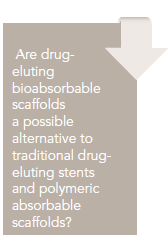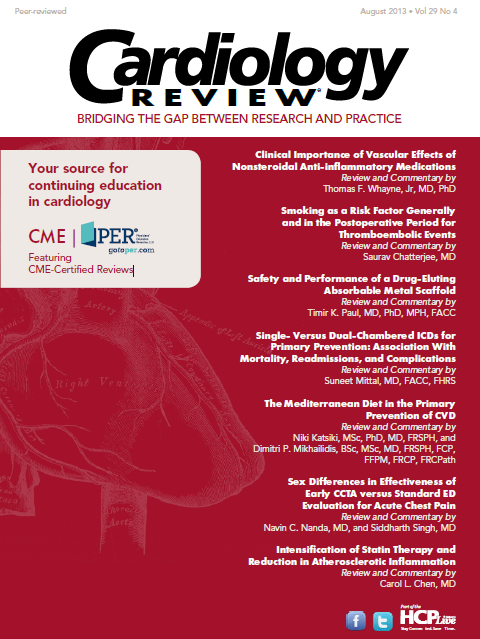Publication
Article
Cardiology Review® Online
Safety and Performance of a Drug-Eluting Absorbable Metal Scaffold

Timir K. Paul, MD, PhD, MPH
Review
Although drug-eluting stents (DESs) have decreased restenosis rates significantly compared with bare-metal stent (BMSs), they have been associated with late in-stent thrombosis at an annual rate of 0.5% to 0.8% despite prolonged dual antiplatelet therapy (DAPT).1-3 Bioabsorbable scaffolds have been developed to reduce the rate of stent thrombosis, to eliminate the long-term use of DAPT, and to provide better assessment of the vessel lumen by computed tomography or MRI imaging.4,5
Study Details

BIOSOLVE-I, a prospective, non-randomized, multicenter, firstin- humans trial, assessed the safety and clinical performance of a magnesium-based paclitaxel-eluting absorbable metal scaffold (DREAMS; Biotronik, Bulach, Switzerland) in patients with de novo coronary lesions. Patients were eligible for inclusion if they presented with stable or unstable angina or silent ischemia with 1 or 2 de novo lesions in 2 separate coronary arteries, lesion length of ≤12 mm, diameter stenosis between 50% and 99%, and vessel diameter of 3.0 mm to 3.5 mm. Patients were excluded for left ventricular ejection fraction <30%, thrombus in the target vessel, severe calcification, 3-vessel disease, bifurcation lesions, ostial lesions, and previous bypass surgery.
DREAMS (3.25 mm or 3.5 mm in diameter and 16 mm in length) is made of a magnesium alloy with complete absorption after 9 to 12 months. The primary end point was target lesion failure at 6 and 12 months, defined as a composite of cardiac death, target vessel myocardial infarction (MI), and clinically driven target lesion revascularization (TLR). Secondary end points were late lumen loss, percentage diameter restenosis, binary restenosis at 6 months and 12 months, procedural and device success, scaffold thrombosis rate, and cumulative rates of target lesion failure at 1, 24, and 36 months. All patients were recommended to take standard doses of dual antiplatelet therapy for at least 12 months with 75 mg aspirin daily and either with clopidogrel or ticlopidine or prasugrel. Patients had angiographic and intravascular ultrasonographic (IVUS) follow-up at 6 months or 12 months.
A total of 46 patients with 47 lesions were enrolled. Stents were delivered and deployed with a 100% device and procedural success rate. Two patients withdrew consent and 1 patient died of noncardiac causes. At 12 months, no cardiac death or scaffold thrombosis was reported, but 3 out of 43 (7%; 95% confidence interval [CI], 1.7-19.3) patients had target lesion failure.
In-scaffold mean acute lumen gain was 1.35 mm (standard deviation [SD], 0.51) with mean acute recoil of 9.19%. There was no statistically significant difference in mean in-scaffold late lumen loss at 6 months versus 12 months (0.65 mm [SD, 0.50] vs 0.52 mm [SD, 0.39]). Similarly, no significant difference was noted in in-scaffold diameter (25.01% [SD, 21.07] vs 20.92% [SD, 16.70]; P = 0.37) and minimum lumen diameter (1.95 mm [SD, 0.59] vs 2.06 mm [SD, 0.47]; P = 0.38) at 6 months versus 12 months. Vessel angulation at the site of scaffold deployment was completely restored after 12 months. IVUS revealed a crosssectional lumen loss of 1.12 mm2 at 6 months and 1.30 mm2 at 12 months. OCT in 7 patients showed 95.9% (95% CI, 95.3- 96.4) of the struts were apposed and 4.1% (95% CI, 3.6-4.7) were incompletely apposed after the procedure. At 6 months, 97.2% (95% CI, 96.7-97.6) of the struts were apposed, and at 12 months, 99.8% (95% CI, 99.6-99.9) of the struts were apposed. At 6 months 0.6% (95% CI, 0.4-0.9) and 2.2% (95% CI, 1.8- 2.6) of the struts and at 12 months 0.1% (95% CI, 0.03-0.3) and 0.1% (95% CI, 0.03-0.3) had persistent incomplete apposition and late acquired incomplete apposition, respectively.
This study demonstrated that the drug-eluting absorbable metal scaffold (DREAMS) is a safe and feasible alternative to the traditional DES and polymeric absorbable scaffolds, with promising angiographic and clinical outcomes for up to 12 months.
Commentary A New Paradigm in Coronary Interventions
Bioabsorbable stents have opened a new paradigm in coronary interventions and have several potential advantages over BMSs or DESs, which include elimination of late stent thrombosis, restoration of vasomotion, and anticipation of reduction in repeat TLR. Studies showed that drug-eluting absorbable polymeric or metallic scaffolds had good safety profiles with optimal short-term clinical performance, but raised the concern of paucity of data on long-term outcomes and lack of comparative data among different types of absorbable stents.
The first polymeric bioabsorbable scaffold (Igaki-Tamai stent) had revascularization rates comparable to BMS but was limited in use mainly due to the need for local heat application for expansion.6 The first-generation bioabsorbable everolimus-eluting coronary scaffold (BVS 1.0) demonstrated a major adverse cardiovascular event (MACE) rate of 3.4% at 12 months without any stent thrombosis; it remained the same at 2, 3, and 4 years of follow-up; and the rate of late lumen loss (0.48 mm at 3 years) was similar to that of permanent DESs.7-10 Due to an increased rate of incomplete strut apposition and late acquired malapposition, second-generation bioabsorbable everolimus-eluting scaffold systems (BVS 1.1, ABSORB, Abbott Vascular, Santa Clara, CA) were developed.7,11 The results of the ABSORB trial at 12 months revealed similar late lumen loss to that of permanent DES, but there were higher MACE rates (7.1% compared with 3.4% MACE in BVS 1.0).7
Bioabsorbable metallic scaffolds are an alternative option to polymeric scaffolds because of their similarity in mechanical performance to that of stainless steel stents.12 The first-in-human, first-generation magnesium-based bare absorbable metal stent (AMS) in coronary arteries was evaluated in the PROGRESS-AMS study, which included 63 patients and showed a good safety profile without any death, MI, or scaffold thrombosis at 12 months.13 Although in-scaffold acute gain was good, in-scaffold late lumen loss and ischemia-related TLR were high at 4 months because of negative remodeling and neointimal proliferation, necessitating the development of a second-generation drug-eluting metallic scaffold with slower absorption.14,15
DREAMS had a good safety profile without any cardiac death or scaffold thrombosis at 12 months. Refinements of the AMS stent and the addition of paclitaxel resulted in significantly less TLR at 12 months (4.7% vs 26.7%) and lower rates of in-scaffold late lumen loss at 6 and 12 months compared with first-generation magnesium scaffolds.
In-scaffold area stenosis in DREAMS at 6 months was similar to that of BVS 1.1 in ABSORB and the Xience in Spirit I.10,16 DREAMS had a 100% device and procedural success rate, whereas 5.3% of BVS scaffold systems required bailout stenting. DREAMS had a higher rate of strut apposition, with 97.2% at 6 months and 99.8% at 12 months; BVS had a rate of 94% at 6 months.10 BVS had restricted distensibility compared with metallic stents. The best long-term data we have so far on the BVS stent showed a sustained low MACE rate of 3.4% without stent thrombosis and any late complications at 4 years.10 We now need a head-to-head comparison of BVS with DREAMS.
The unique feature of DREAMS was regaining the original shape and angulation of the scaffolded vessel segment after resolution. Biodegradation of BVS resulted in return of normal vasomotion function of the stented vessel, proved by acetylcholine and methergine tests.
This study has several limitations. It is neither a randomized nor a comparison study and has a small sample size and limited follow-up results. The absence of direct comparison with other permanent stents or absorbable scaffolds is a major drawback. This study is the first-in-human experience and only includes 46 patients (4% with unstable angina) with type A and B lesions. Therefore, the results of this study would not be generalizable to other types of lesions, especially complex and calcified lesions, or to patients with acute coronary syndrome (ACS). This study used paclitaxel instead of limus derivatives (everolimus and sirolimus), which showed lower restenosis rates than paclitaxel. Future studies using limus drug with this same metallic scaffold need to be conducted for comparison. The percentage of mean acute recoil was high (9.19%) in this study.
There are several questions that arise from this trial. The first is whether the rate of stent thrombosis continued to be zero in longterm follow-up, especially after discontinuation of DAPT after 1 year. This is a “million-dollar question.” Although we anticipate short-term use of DAPT with this stent, what would be the optimal duration of DAPT—3 months versus 6 months versus 1 year? If we still need 1 year of DAPT (as used in this study) for absorbable stents, what difference would be realized, as current guidelines recommend 12 months of DAPT for DES anyway? The other goal of absorbable stents is complete resorption of the scaffold after 9 to 12 months, which would facilitate further revascularization with coronary artery bypass graft or percutaneous reintervention using stents. With DREAMS the wait remains 12 months, however.
Despite these limitations, I am optimistic about the result of the BIOSOLVE-1 trial, and convinced that the DREAM stent is safe and has performed optimally. Although at this moment this stent would not be applicable for type C, calcified, ostial, bifurcation, and small-vessel lesions and in patients with ACS, it would be useful in certain patients with simple lesions. Even though it could be useful in few patients, reducing the duration of DAPT and the adverse consequences of DAPT would reduce overall costs associated with the DREAM stent.
I don’t foresee a change in clinical practice yet with this promising but limited data on DREAMS. Although we have a long way to go, when fully evolved, bioabsorbable stents will be as close as stents could come to human vessels. However, achieving balance between metal, polymer, and rate of degradation is definitely a challenge. Evolving stents are overcoming previous limitations and getting closer and closer to a clinically balanced and optimally functioning stent.
Further research is imperative with more patients, longer follow- up, and randomized, controlled trials comparing the clinical outcomes and angiographic parameters of current DES versus absorbable scaffolds and drug-eluting absorbable polymer scaffolds versus drug-eluting absorbable metal scaffolds. I believe that in the future, patients themselves might push for these stents as nobody wants a metal stent left in their body forever.
References
1. Daemen J, Wenaweser P, Tsuchida K, et al. Early and late coronary stent thrombosis of sirolimus-eluting and paclitaxel-eluting stents in routine clinical practice: data from a large two-institutional cohort study. Lancet. 2007; 369:667-678.
2. Lasala JM, Cox DA, Dobies D, et al. Drug-eluting stent thrombosis in routine clinical practice: two-year outcomes and predictors from the TAXUS ARRIVE registries. Circ Cardiovasc Interv. 2009;2:285-293.
3. Lagerqvist B, James SK, Stenestrand U, Lindback J, Nilsson T, Wallentin L. Long-term outcomes with drug eluting stents versus bare metal stents in Sweden. N Engl J Med. 2007;356:1009-1119.
4. Lind AY, Eggebrecht H, Erbel R. Images in cardiology: the invisible stent: imaging of an absorbable metal stent with multislice spiral computed tomography. Heart. 2005;91:1604.
5. Eggebrecht H, Rodermann J, Hunold P, et al. Images in cardiovascular medicine: novel magnetic resonance-compatible coronary stent: the absorbable magnesium-alloy stent. Circulation. 2005;112:e303-e304.
6. Tamai H, Igaki K, Kyo E, et al. Initial and 6-month results of biodegradable poly-L-lactic acid coronary stents in humans. Circulation. 2000;102:399-404.
7. Serruys PW, Onuma Y, Dudek D, et al. Evaluation of the second generation of a bioresorbable everolimus-eluting vascular scaffold for the treatment of de novo coronary artery stenosis: 12-month clinical and imaging outcomes. J Am Coll Cardiol. 2011;58:1578-1588.
8. Serruys PW, Ormiston JA, Onuma Y, et al. A bioabsorbable everolimus- eluting coronary stent system (ABSORB): 2-year outcomes and results from multiple imaging methods. Lancet. 2009;373:897-910.
9. Onuma Y, Serruys PW, Ormiston JA et al. Three-year results of clinical follow up after a bioresorbable everolimus-eluting scaffold in patients with de novo coronary artery disease: the ABSORB trial. Eurointervention. 2010;6:447-453.
10. Dudek D, Onuma Y, Ormiston JA, Thuesen L, Miquel-Hebert, Serruys PW. Four-year clinical follow up of the ABSORB everolimus-eluting bioresorbable vascular scaffold in patients with de novo coronary artery disease: the ABSORB trial. Eurointervention. 2012;7:1060-1061.
11. Ormiston JA, Serruys PW, Regar E, et al. A bioabsorbable everolimus- eluting coronary stent system for patients with single de-novo coronary artery lesions (ABSORB): a prospective open-label trial. Lancet. 2008;371:899-907.
12. Waksman R. Promises and challenges of bioabsorbable stents. Catheter Cardiovasc Interv. 2007;70:407-414.
13. Erbel R, Di Mario C, Bartunek L, et al; PROGRESS-AMS (clinical performance and angiographic results of coronary stenting with absorbable metal stents) Investigators. Temporary scaffolding of coronaries with bioabsorbable magnesium stents: a prospective, nonrandomized muiticentre trial. Lancet. 2007;369:1869-1875.
14. Erbel R, Di Mario C, Bartunek J, et al. Temporary scaffolding of coronary arteries with bioabsorbable magnesium stents: a prospective, nonrandomised multicentre trial. Lancet. 2007;369:1869-1875.
15. Waksman R, Erbel R, Di Mario C, et al. Early- and long-term intravascular ultrasound and angiographic findings after bioabsorbable magnesium stent implantation in human coronary arteries. JACC Cardiovasc Interv. 2009;2:312-320.
16. Ormiston JA, Serruys PW. Bioabsorbable coronary stents. Circ Cardiovasc Interv. 2010;3:384-393.
About the Author
Timir K. Paul, MD, PhD, MPH, FACC, is Assistant Professor, Division of Cardiology, Department of Medicine, and Director of Cardiac Rehabilitation and Prevention at Quillen College of Medicine, East Tennessee State University, Johnson City, TN. He received his MD from Dhaka Medical College, University of Dhaka, Dhaka, Bangladesh, and his PhD and MPH degrees from Tulane University. Dr. Paul did his fellowship in cardiology at Ochsner Clinic, New Orleans, LA, and in interventional cardiology at the University of North Carolina, Chapel Hill. He has published many original research articles and reviews.
Haude M, Erbel R, Erne P, et al. Safety and performance of the drug-eluting absorbable metal scaffold (DREAMS) in patients with de-novo coronary lesions: 12 month results of the prospective, multicentre, first-in-man BIOSOLVE- 1 trial. Lancet. 2013;381:836-844.
